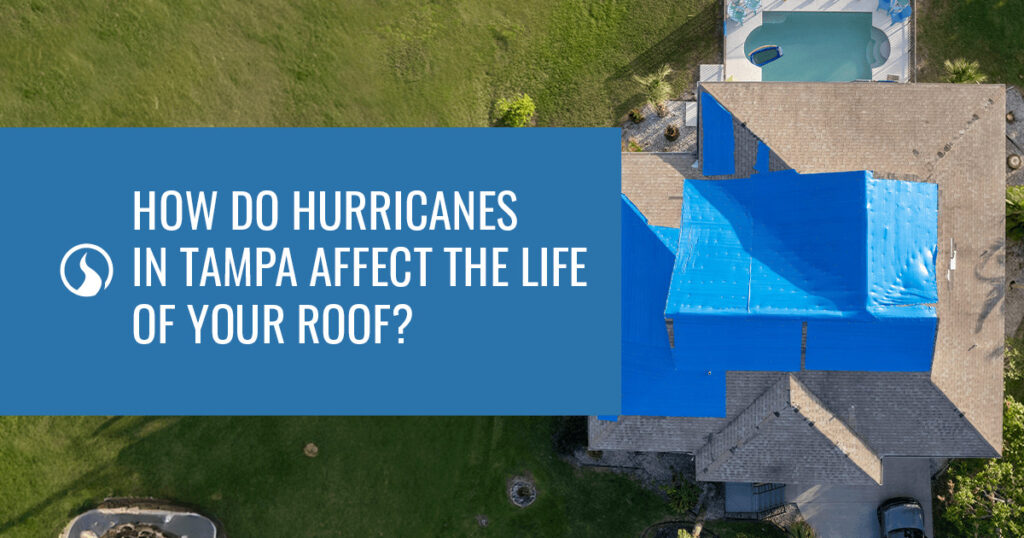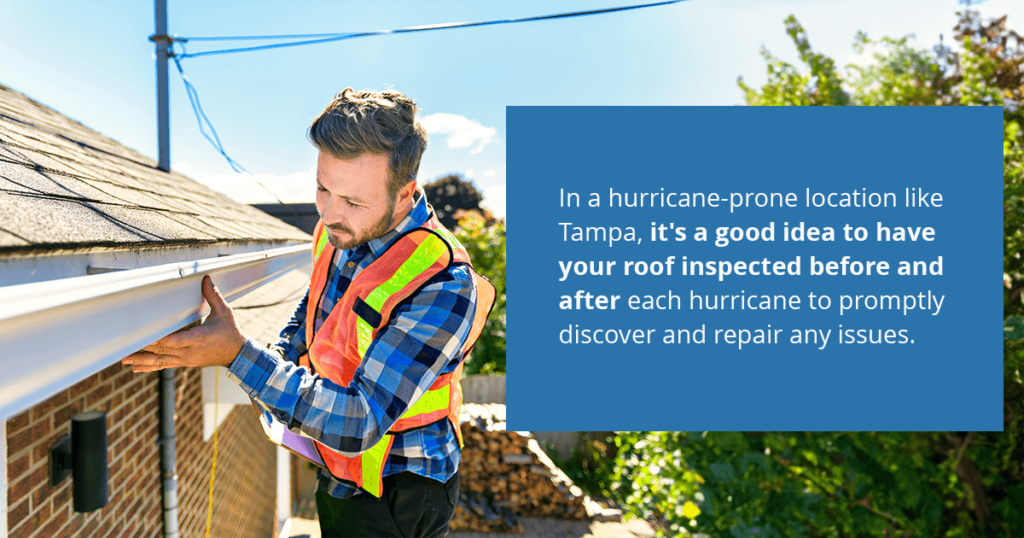How Do Hurricanes in Tampa Affect the Life of Your Roof?

As a Florida resident, you’re likely used to prepping your property for severe storms. Homeowners like you are particularly at risk for property damage during hurricane season, which lasts from June to November. Taking the proper precautions to protect your home and roof can save you time, money and the stress of dealing with insurance claims. While many people may think their roof can weather the storm, there’s no way to predict how a hurricane could affect your home.
Strong winds, debris and heavy rain can escalate damage very quickly, and frequent storms can weaken your roof over time. To help you implement proactive measures, we’re here to discuss how hurricanes affect roofs in Tampa so you can fortify your home against Mother Nature.
How Can Hurricanes Affect the Life of a Roof in Tampa?
Though you can prepare in time for a hurricane, there’s no telling what severe weather elements can do to your roof during a storm. The severity of the damage generally correlates to the category of the hurricane. However, high winds and rain are almost always expected. A combination of the following elements can inflict even more damage:
- High winds: According to the Saffir-Simpson scale, hurricane winds can range from 74 to 157 miles per hour or more. Even a Category 1 hurricane can cause extensive damage to your roof. Tall structures like homes are exposed to higher wind velocities, and years of sustained high winds can create holes in your roof and loosen your shingles. Strong winds can worsen an already damaged roof and require you to replace it sooner than necessary.
- Heavy rain: Hurricane season often brings heavy rain, which can expose your roof to leaks. Rainwater or wet debris that stays stagnant on a roof for an extended period of time can also lead to water damage or rot that greatly impacts your roof’s durability.
- Falling debris: Roof damage from wind-swept branches or falling trees is common during hurricanes. This type of damage is not always preventable, even if you don’t have any large trees around your home. Broken tree limbs and debris can travel miles in high winds and floods, leaving your home’s exterior vulnerable. Even healthy and strong trees can collapse in an intense storm.
- Lightning: Florida is the lightning capital of the world, so Tampa homeowners are likely to experience it even more during hurricane season. Lightning can strike powerlines, trees, nearby structures or your roof itself. A single lightning strike can destroy shingles, tear off your gutters or start a fire.
- Hail: Although extremely rare, you may experience hail damage during a hurricane. Hailstones can overcome the storm’s strength when they become large enough, causing them to fall to the ground. Coupled with heavy wind and the right conditions, hail can easily chip away at your roofing structure or break down a fragile roof.
Roof damage sustained by any — or all — of these weather elements can shorten the life span of your roof. Even a few missing asphalt shingles can result in leaks and leave your roof exposed to more structural damage.
What to Do If You Have Roof Damage After a Hurricane
If a hurricane or major storm has caused severe damage to your roof and home, you’ll likely need to file a claim with your insurance company. Review your policy first to determine if you have coverage for the type of damage your home sustained. It’s best to act quickly when you submit a claim if you need your insurance company to repair or replace your roof, otherwise it may be denied.
You’ll want to take pictures of any issues caused by the storm, including:
- Loose siding
- Clogged gutters
- Missing or broken shingles
- Leaks
- Holes
- Branches and debris
Keep in mind that insurance companies may deny claims for damaged roofs if there is proof that you have neglected maintenance over the years. For example, if an inspector determines your roof had significant wear and tear before the hurricane hit, you’ll likely end up responsible for repairing the storm damage.
This is why it’s important to keep up with roof maintenance on a regular basis. If you only need a few minor repairs, it might be easier to use a trusted construction company instead of going through insurance. Getting a second opinion from roofing experts who specialize in high-quality roofing can help you choose the best course of action.
Even if there is no visible damage after a hurricane, it’s critical to have a professional inspect your roof for hidden issues. For instance, you might not be able to tell if your shingles are loose, but an expert can. This can help prevent leaks and further damage. Having documented roof repairs can increase your chances of getting an approved claim if you do need to file.

How to Mitigate Roof Damage in the Future
Being proactive is the first step to preventing and minimizing hurricane roof damage. Here are some helpful tips to protect roofs in Tampa from hurricanes:
1. Trim Nearby Trees
Ahead of a major storm or hurricane, it’s crucial to trim any overhanging tree branches that are too close to your home. This is also a good opportunity to remove anything in your yard that could become a projectile in high winds.
2. Clean Out Gutters
Gutters are responsible for keeping water away from your home. Clogged or damaged gutters can cause water to build up on the roof’s surface or trap it under the coating. This can result in leaks in your interior ceiling. Periodically clearing out your gutters can help them drain properly and help protect your roof against a hurricane.
3. Stay Up to Date on Inspections
Skilled professionals will be able to properly evaluate your roof and check that everything is secure. In a hurricane-prone location like Tampa, it’s a good idea to have your roof inspected before and after each hurricane to promptly discover and repair any issues.
Regular inspections and maintenance can also improve the likelihood of being approved for insurance coverage. Neglecting preventive maintenance, however, can result in denied insurance claims for roof damage and more extensive damage.
4. Schedule Repairs
Regardless if it’s hurricane season or not, it’s essential to get roof repairs taken care of as soon as possible. Postponing repairs might not seem like an issue, but it only takes one high-wind storm to turn minor impairments into costly destruction.
Contact Coldstream Exteriors for Your Expert Tampa Roofing Needs
Even the smallest storms can weaken your roof over time. Fortifying your roof before another hurricane hits can save you money and stress. Whether you need a replacement or a minor repair, it’s important to ensure your roof is well-maintained with premium products. At Coldstream Exteriors, we prioritize customer safety and home integrity through our high-quality, expert roofing services to help protect your roof against the elements. Our team of experienced professionals will help you with all your roof repair and replacement needs.
Because we value customer satisfaction above all, we’re proud to start your roofing project with no payments required until completion. Coldstream Exteriors also offers flexible low-financing options and industry-leading warranties to all our customers.
Once we arrive, our Tampa-based roofing company experts will conduct a thorough inspection, assist with leaks, update shingles and make suggestions for your home’s exterior needs. If you’re located in the Greater Tampa area, we’d love to add you to our long list of satisfied customers. Get started by scheduling your free inspection today.

